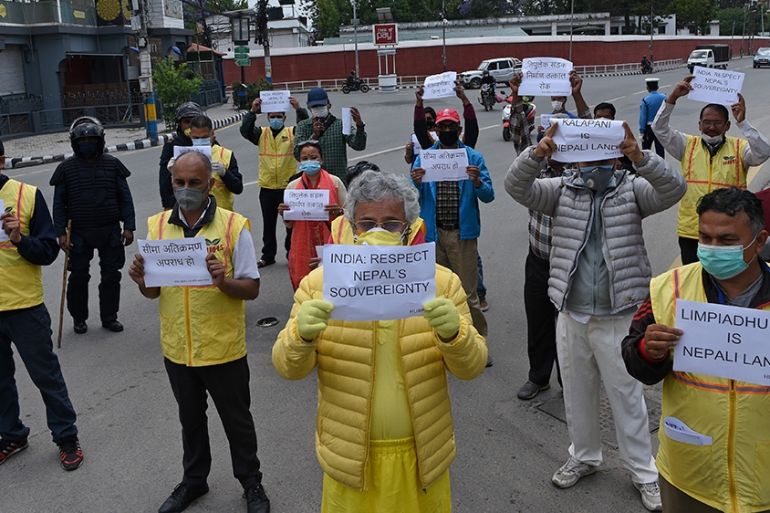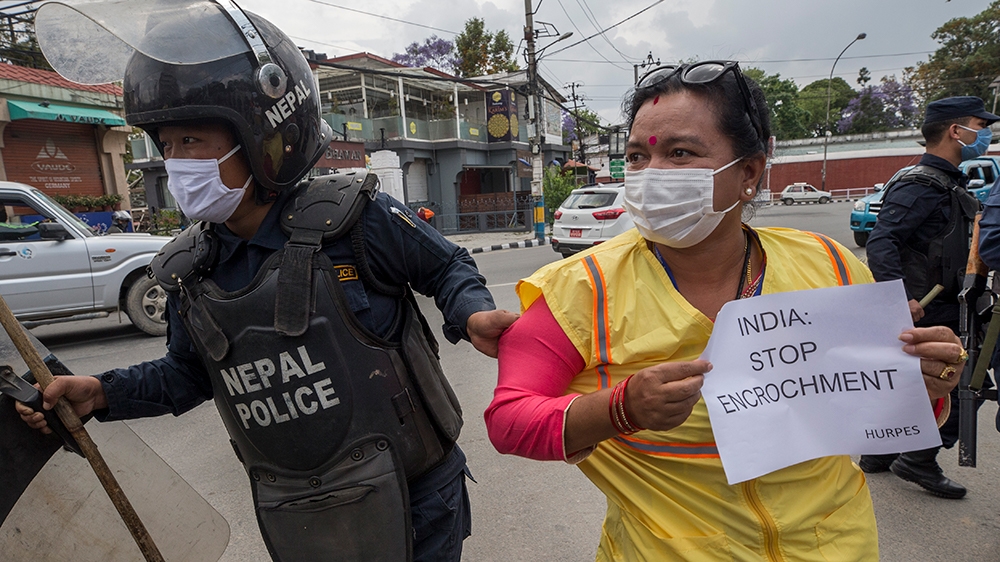What is the way forward in India-Nepal border dispute?
India says new road to Lipulekh falls within Indian territory, but Nepal claims at least 17km of it lies on its land.

Kathmandu, Nepal – For several weeks, Indian soldiers have been engaged in a standoff with their Chinese counterparts along their disputed border, even as New Delhi is busy planning a strategy to resolve a land dispute with another neighbour, Nepal.
India’s latest diplomatic row with Nepal erupted on May 8 when New Delhi announced the inauguration of a Himalayan road link that passes through the disputed area of Kalapani.
Keep reading
list of 3 itemsNew Nepal map heightens land dispute with India
India’s updated political map stirs controversy in Nepal
Under pressure from the opposition, civil society and a vociferous Nepali press, the government of Prime Minister Khadga Prasad Sharma Oli issued a new political map of the country, showing Kalapani, Lipulekh and Limpiyadhura within its borders.
India objected, saying the new Nepal map “included parts of the Indian territory”.
The dispute’s origins lay in the November 2019 release of India’s new political map, which showed Kalapani within India.
The announcement saw Nepal’s capital Kathmandu rocked by protests, while Oli’s government requested a high-level meeting to resolve the dispute. But India was not forthcoming.
The two neighbours entered a new paradigm of “cartographic war” as anger grew on both sides.

Acrimonious exchanges
It began with an ill-placed remark by the Indian army chief, General Manoj Mukund Naravane, that suggested Kathmandu had acted at the behest of China.
Nepal’s Defence Minister Ishwor Pokhrel dubbed General Naravane’s comments an insult to the Nepali soldiers working in the Indian Army. Nearly 40,000 Nepali Gurkha soldiers are part of 40 battalions.
Not to be outdone, Prime Minister Oli questioned India’s commitment to its national motto of “Satyamev Jayate” (truth prevails) by suggesting New Delhi subscribed to “Singhamev Jayate” (the lion prevails).
His remarks about the “Indian virus” spreading the coronavirus pandemic into Nepal added fuel to the fire.
Oli’s nationalist position seemed to be directed at his domestic audience as he used the issue to deflect criticism from his government’s handling of the pandemic, as well as consolidate his beleaguered position within his party.
But experts believe New Delhi risks damaging the relationship further through its hawkish commentators and nationalist media.
“Oli’s response did not precede but followed the public uproar,” said Akhilesh Upadhyay, former editor of The Kathmandu Post and a senior fellow at the Institute for Integrated Development Studies (IIDS), a Kathmandu-based think-tank.
He pointed at Nepali objections to the 2015 bilateral agreement between India and China that opened up Lipulekh for trade, to say Nepal’s position has remained consistent despite multiple governments.
India has argued that the road is completely in its territory but Nepal says at least 17km of the new road “passes through Nepali territory,” arguing that the road crosses over to the east bank of the Mahakali River.
Nepal considers east of the river to be its territory based on the 1816 Sugauli Treaty signed with British colonial rulers.
In a series of articles, Kantipur, Nepal’s biggest-selling newspaper, presented the historical evidence: Five British-Indian maps issued between 1819 and 1894 that show Limpiyadhura as the headwaters of the Mahakali; a 1904 letter written by then Prime Minister Rana Chandra Shamsher to village chiefs of the triangle; and evidence of a 1958 voter list and the 1961 census by Nepali authorities in the region.
Nepal also possesses land registration records and tax receipts from the disputed territory.

“The heart of the dispute,” Upadhyay said, “lies in differing cartographic interpretations about the headwaters of the Mahakali river.” Nepal argues Limpiyadhura is the location of the headwaters; India regards a smaller stream flowing down from Lipulekh as the river’s headwaters.
The dispute is further muddied by the presence of Indian troops in Kalapani since before the 1962 war with China.
The Sugauli Treaty remains, for Nepal, the “mother of all documents”, Upadhyay said, according to which the Mahakali is the boundary river between the two countries, and any future demarcations will be based on the treaty.
What is the way forward?
The row appears to have reached an impasse.
“The Nepal prime minister’s earlier remarks on a solution, with possible road leasing to India, was a welcome step towards de-escalation, but since then, we have only seen repeated moves from both sides that have raised the temperature, further politicised the issue and thus made dialogue more difficult,” said Constantino Xavier, a fellow at Brookings India.
Similarly, Sudheer Sharma, editor of Kantipur daily, said, “The dispute has become more complicated after a hardening of stances on both sides. Nepal’s earlier demands were focused on the withdrawal of troops from Kalapani; its recent position now includes the insistence of Limpiyadhura as the headwaters. The dispute looks like it is heading towards a point of no return.”
The presence of the Indian army in the trijunction that connects India, China and Nepal complicates the issue.
Analysts say it is difficult to foresee a withdrawal of troops, as the official Nepali position demands.
Sharma said: “There had been proposals in the past where India would withdraw its troops while Nepal would guarantee Indian security interests in the region. But this looks difficult now.”
The situation acquires a further hurdle against the background of a simmering India-China border dispute along their de facto border – the Line of Actual Control (LAC) – a border that remains undemarcated.
Furthermore, Nepal’s ruling Communist Party government has reached out to China for investment and better connectivity in recent years, which has troubled India.
But Beijing’s ambiguous position that Kalapani is a bilateral issue between India and Nepal has been keenly watched by Nepali analysts since the current road is a result of its 2015 agreement with New Delhi.
Despite the tensions – the second over Kalapani in six months and the most serious bilateral dispute since the 2015 unofficial blockade – analysts on both sides have begun to call for a political solution to Kalapani.
India may continue to defuse the crisis through back channels, said Xavier from Brookings, but “this is no longer sustainable”, as the dispute had become a “permanent irritant” in bilateral relations.
Similarly, Upadhyay said because both sides have an “irreconcilable position”, the dispute will not end “based on cartography”.
Broader engagement from both sides is essential towards finding a solution that satisfies both sides, said Xavier.
“There are many possible modalities. Maybe it could include joint military deployment, special access rights for Nepali citizens or even a free-trade zone with China,” he said.
Many have also pointed to India’s resolution of the border with Bangladesh in 2015 – “far more intractable”, according to Jayant Prasad, ex-ambassador to Nepal – as a possible way out.
Most of the 1,751km-long Nepal-India border has been demarcated through a joint boundary committee except for Kalapani and Susta, which lies in southern Nepal.
“[The] India-Nepal border issues appear more easily solvable, so long as there is political goodwill and statecraft exercised on both sides. The way to move forward is to formally approve the strip maps, resolve the two remaining disputes, demarcate the entire India-Nepal boundary, and speedily execute the work of boundary maintenance,” Prasad wrote in The Hindu.
However, Sharma of the Kantipur daily cautioned that dialogue looks unlikely soon.
“There are new complications because positions have hardened on both sides. Further, more than India, it may not be as easy for the Nepali side to come to a political solution because of the domestic backlash any leadership that negotiates on Kalapani will face.”
Although the Nepali position has hardened over perceptions that New Delhi has not been forthcoming in Kathmandu’s efforts to resolve the dispute, India sought to defuse the crisis on Friday by calling for “constructive and positive efforts”, and said that it had taken the dispute’s “seriousness” into account.